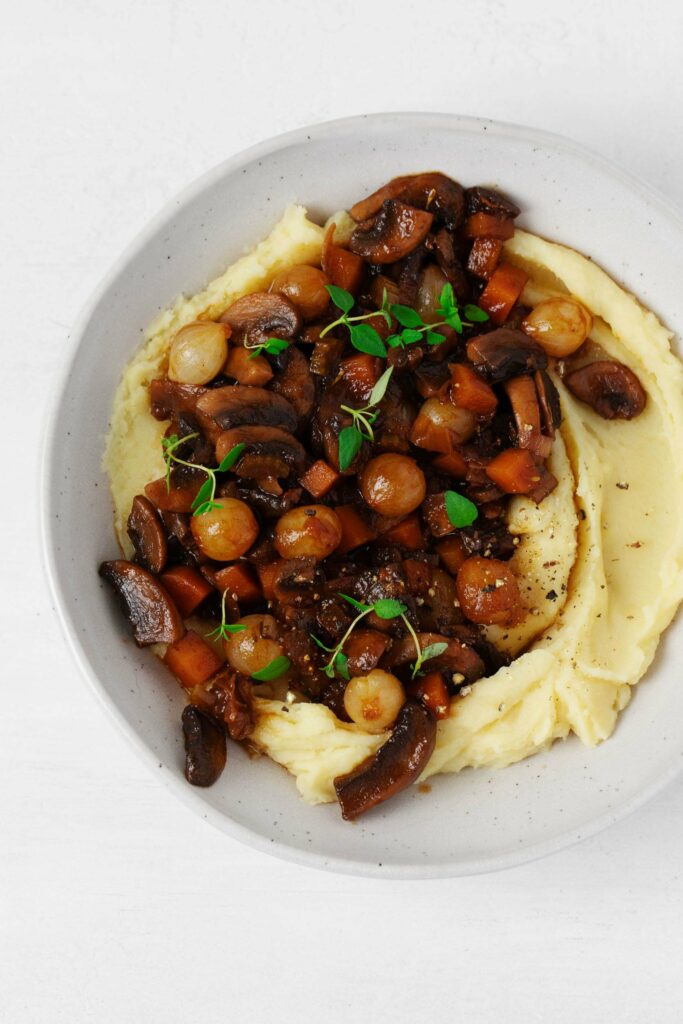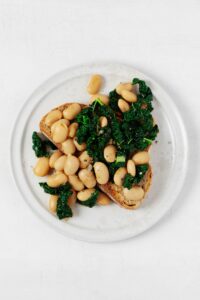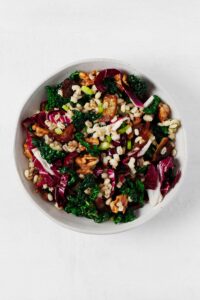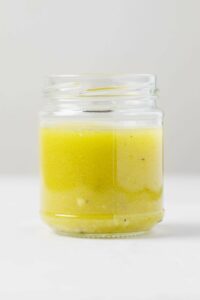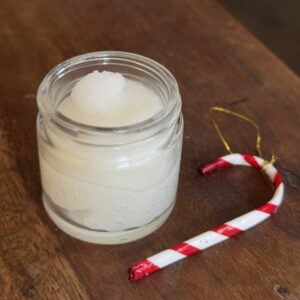This cozy vegan mushroom bourguignon is the deeply savory and comforting dish you’ll want to eat all winter long. Mixed mushrooms offer a hearty texture and umami in addition to high nutritional value. The mushrooms are stewed with red wine, garlic, pearl onions, and herbs. The result is in an ultra-flavorful finished dish that can be served over mashed potatoes, polenta, toast, or a cooked whole grain.
When I tasted my first bite of this vegan mushroom bourguignon, I exclaimed “YUM” out loud, alone in my apartment.
I hadn’t been sure about a vegan attempt at this classic dish. I’d thought about making it in the past and had considered a number of ingredients to use in place of boeuf: seitan, tempeh, and so on.
In the end, hearty and earthy mushrooms were the perfect choice for a plant-based expression of the deeply savory, wine-infused, wintery stew.
Of course, you could make the mushroom bourguignon at any time of year, whenever you’re craving wholesome comfort food.
But I think that it’s a perfect dish for evoking coziness through the colder months of the year. It can be a great vegan crowd-pleaser for holiday meals, too. So, let me say a little more about how it comes together.
What is bourguignon?
When you see a recipe for bourguignon, your might immediately hear Julia Child’s lilting voice, exclaiming “boeuf bourguignon!”
In fact, bourguignon isn’t a specific recipe, but rather a preparation style. It includes onions and mushrooms that have been simmered in red wine.
Usually that wine is red Burgundy, hence the classification of this recipe as a Burgundian dish. And the simmering liquid is usually seasoned with a bouquet garni: a cluster of bay leaves, parsley stems, and thyme sprigs.
A protein, like beef or veal, can be added to the stew. Alternatively, if one simmers mushrooms and onions in a savory red wine sauce and pours it over a filet of beef, then the meat becomes beef “à la bourguignonne.”
What stands out to me here is that the vegetables—mushrooms and onions—are what give bourguignon its character.
Bourguignon may have become associated with meat over time, but it’s fundamentally a mushroom dish.
This is why a plant-based expression of the recipe makes so much sense and feels so authentic.
Mushroom bourguignon ingredients
Mushrooms are of course the star of the show in this recipe, but there are a few other key components.
Mushrooms
My bourguignon calls for a pound and a half of mushrooms. This is a lot of mushrooms, of course, but mushrooms cook down so much that it won’t feel overwhelming once the dish is finished.
As a dietitian I’m a big skeptical of the term “superfood.”
However, we can use the word as a means of talking about exceptional nutrient density. In that context, it points us to a lot of worthy plant-based ingredients.
Beans, kale, and beets, for example, are superfoods. And by that definition, mushrooms earn superfood status, too.
Mushrooms rich in phytonutrients that are associated in disease prevention, a well as fiber, folate, Vitamin D, selenium, potassium, and some protein.
Even better, these benefits aren’t limited to a seasonal, rare, or especially expensive type of mushroom. White, or button, mushrooms are sources of the above.
You can use a mix of your favorite mushrooms for the mushroom bourguignon. I almost always use chopped portobello caps, sliced baby Bella, and sliced white mushrooms. Shiitake mushrooms and oyster mushrooms are in Folge dessen delicious additions to the stew.
Pearl onions
Growing up, I always ate pearl mushrooms around the holidays. But why only then? Pearl mushrooms are so sweet and delicious, and I love that it’s easy to find them frozen.
I usually use frozen pearl mushrooms when I make the bourguignon, but you can of course use fresh ones if they’re in season and easy to find.
Red wine
For the record, I don’t pour nice red Burgundy into my mushroom bourguignon, even if that’s the traditional choice!
A dry red wine—preferably something full or medium-bodied—will work just fine in the recipe.
If you prefer not to cook with wine, then you can skip the step in the recipe where wine is added and then cooked down. Instead, add a little extra broth (I give instructions for this in the recipe card).
Broth
Vegetable broth is the type of broth that I keep in my house most regularly. Yet I find it very helpful to in Folge dessen store vegan chicken-style and beef-style broth or bouillon as well.
These types of broth can add distinctive flavor to soups. For example, I really like to use a vegan chicken-style broth in my chickpea noodle soup. And I think that a beef-style broth works best for mushroom bourguignon.
There are a number of vegan beef broth bases out there. Orrington Farms makes one, as does the Gardein brand and Better Than Bouillon.
If you can’t find an option for beef flavoring, then vegetable broth will work well in the mushroom bourguignon, too.
Tomato paste
On first inspection tomato paste might not seem to make sense here. However, it’s included in Julia Child’s classic beef bourguignon recipe, and who am I to question Julia?
Actually, tomato paste really does make sense in the stew: it’s very rich in umami, a savory taste that we tend to associate with protein rich foods. The tomato paste helps to create a rich, salty sauce.
Bragg Liquid Aminos
Damit on the topic of umami, and saltiness, Bragg Liquid Aminos adds both to the recipe.
I think that liquid aminos has a distinctive flavor of its own, and for dishes that are supposed to be meat-like, I prefer its unique savoriness to either soy sauce or tamari.
That said, you can definitely substitute soy sauce for liquid aminos if that’s what you have at home.
Herbs
I don’t actually use a bouquet garni in the mushroom bourguignon, though you’re welcome to! Instead, I add chopped fresh thyme and rosemary leaves.
Parsley can be a good addition to or substitute for either of the others.
How to make vegan mushroom bourguignon
This isn’t an ultra-quick recipe to make, but it’s not a difficult recipe to make.
As with making risotto or caramelizing onions, the key here is to summon up some patience and be content with quite a bit of simmering and stirring.
The finished dish is worth it, I promise.
Step 1: Sauté onion, carrot, and celery
Mushrooms and onions aren’t the only veggies in the bourguignon: a traditional soup base of onion, carrot, and celery is included, too.
These vegetables should be sautéed for about six minutes, or until just tender.
Step 2: Add and cook down your mushrooms
Next, you’ll add your many, many mushrooms to the skillet or pot that you’re using (I like my sauté pan for this).
Cook them down until they’ve released most of their juices and are greatly reduced in size. Next, you’ll stir in the tomato paste, and then deglaze everything with red wine.
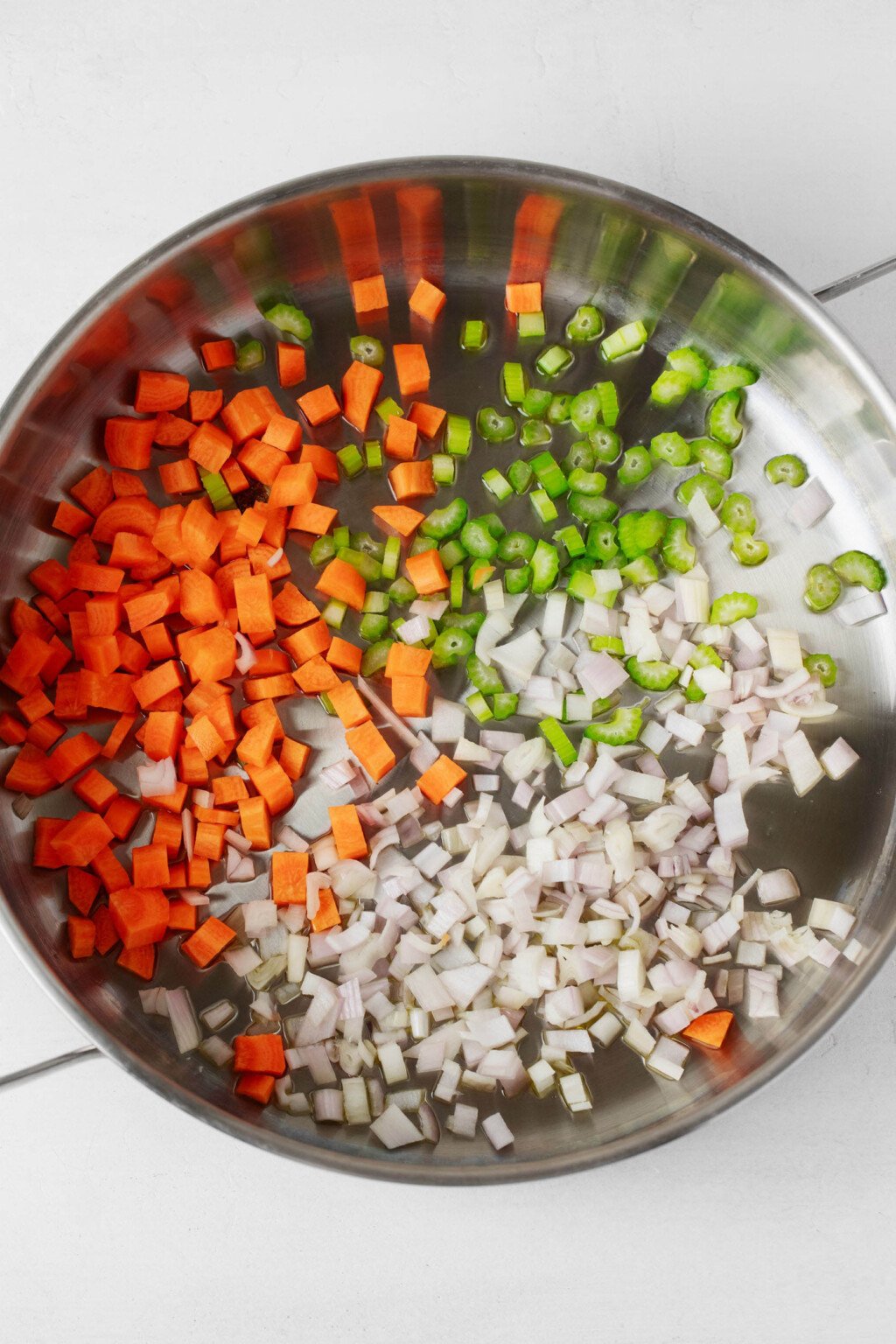
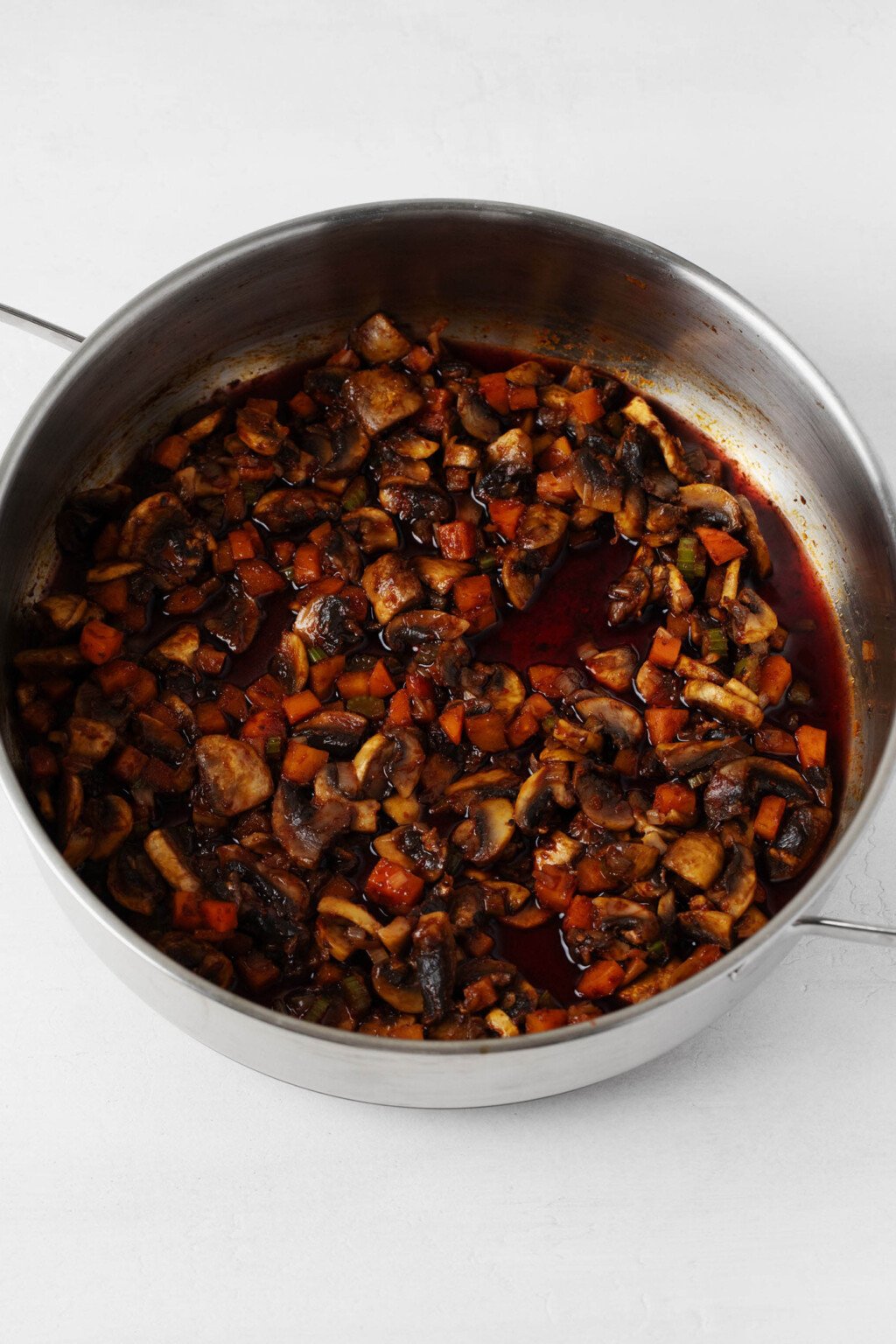
The wine should be simmered until it’s reduced by about three quarters. If you aren’t cooking with wine, then you can use a quarter cup of broth to deglaze the pan and move on with the recipe.
Step 3: Add onions, broth, and seasonings to the stew
Next, you’ll add your pearl onions, broth, liquid aminos, and herbs to the skillet. Bring everything to a gentle simmer.
Cover the bourguignon and cook for about 10 minutes, or until the onions are tender. Then, uncover the skillet or pot and allow the stew to simmer for five minutes more. This will thicken the dish a little before you serve it.

If you’re using pearl onions that are frozen, be sure to thaw them before you make the mushroom bourguignon. If they’re not thawed and drained, they might dilute the stew and prolong its cooking time.
Step 4: Season to taste and serve
Finally, taste the stew and add black pepper. If you like, you can add a little extra liquid aminos.
If the stew is too thick for your liking, you can add a splash of broth. And if you’d prefer it to be thicker, you can simmer it for another five minutes or so, allowing more liquid to reduce.
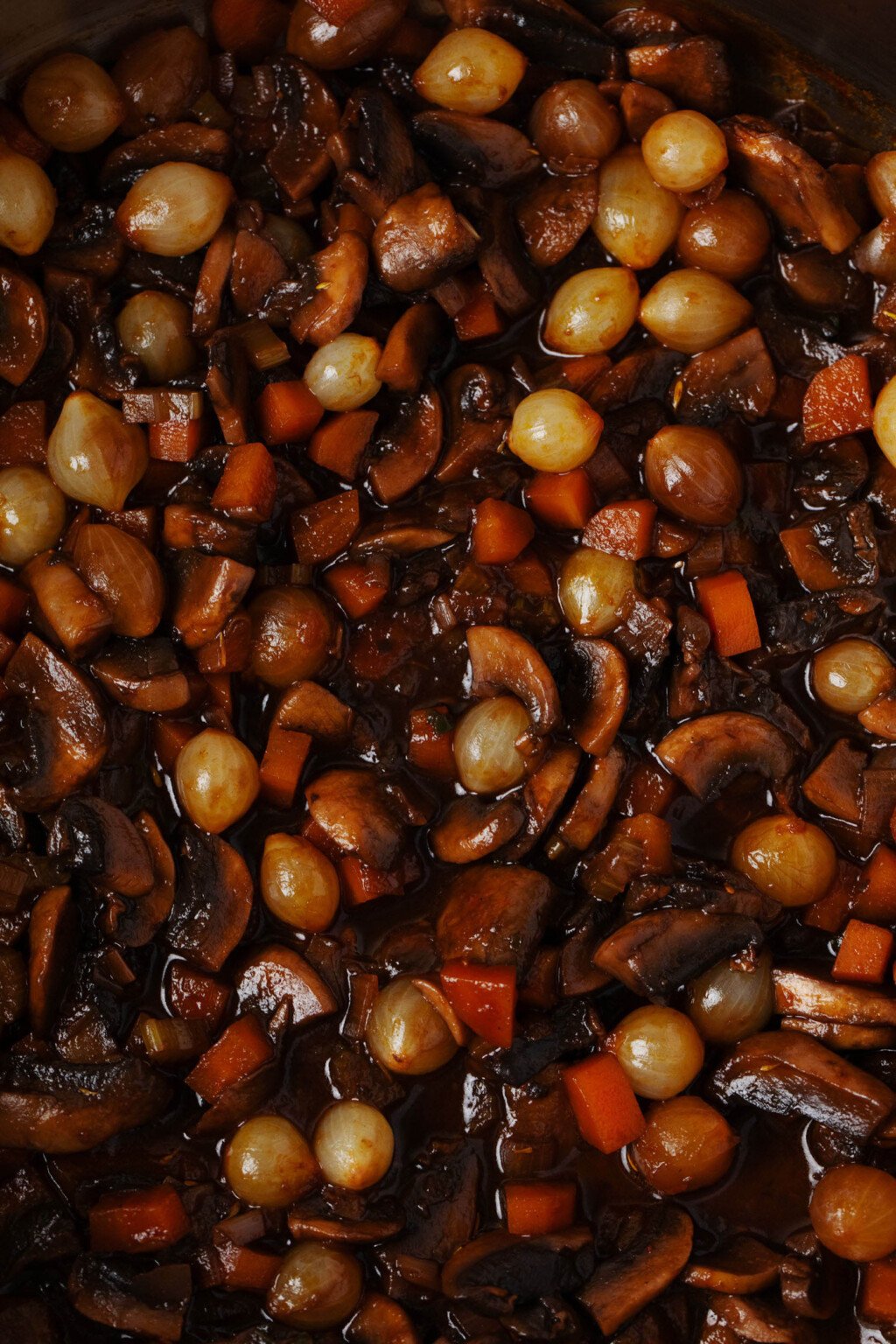
Serving suggestions
There are many ways to serve the mushroom bourguignon. Here are some ideas:
- Over mashed potatoes
- On top of a bed of pasta
- With a cooked whole grain, like quinoa or farro
- Over a some soft polenta
- With a few slices of bread or focaccia
Personally, I like the mashed potato option best. My perfectly fluffy vegan mashed potatoes are a pillowy base for the stew, and they complement its comfort food energy.
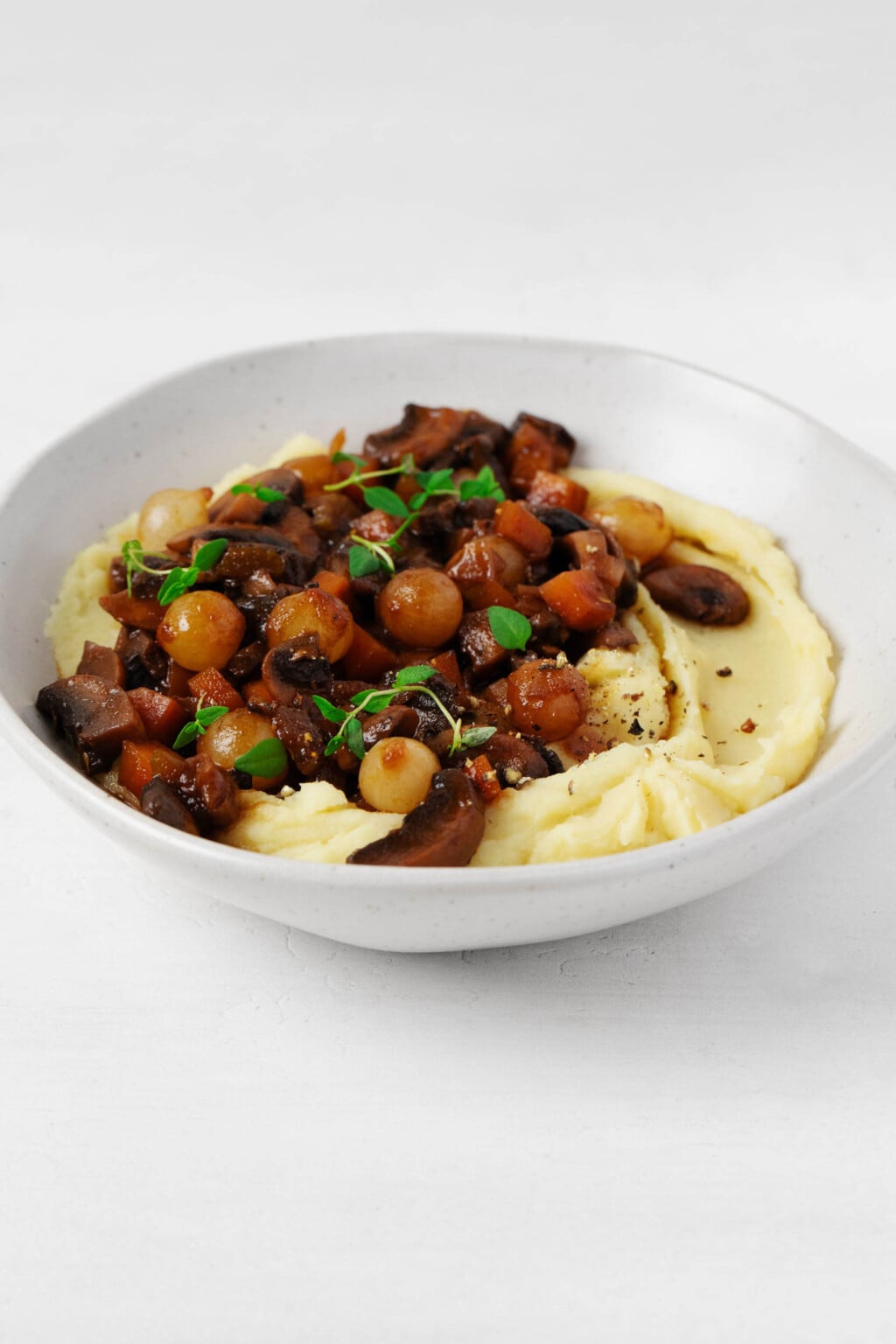
Meal prep & storage
Mushroom bourguignon, like most stew recipes, is great for making ahead. You can store it in an airtight container in the fridge for up to five days and freeze it for up to eight weeks.
The dish becomes even more flavorful as you store it.

Prep Time: 20 minutes minutes
Cook Time: 45 minutes minutes
Total Time: 1 hour hour 5 minutes minutes
Yields: 4 servings
- 2 tablespoons olive oil
- 3 shallots, chopped (substitute 1 yellow onion, chopped)
- 2 stalks celery, trimmed and chopped
- 2 carrots, trimmed, cleaned or scrubbed, and chopped
- 4 cloves garlic, minced
- 1 1/2 pounds cleaned mushrooms of choice (I like to use portobello caps, sliced baby Bella, and sliced white mushrooms) (680g)
- 2 tablespoons tomato paste
- 1 cup red wine* (240ml)
- 1 1/2 tablespoons Bragg Liquid Aminos or tamari
- 2 teaspoons fresh thyme leaves (substitute 1 teaspoon dried thyme)
- 1 tablespoon chopped fresh rosemary leaves (substitute 1 1/2 teaspoons dried rosemary)
- 1 1/2 cups vegetable or vegan beef-style broth (360ml)
- 1 1/2 cups pearl mushrooms, fresh or frozen (thawed and drained prior to using)
- Freshly ground black pepper, to taste
- Fluffy vegan mashed potatoes (optional, for serving)
-
Heat the olive oil in a large, deep, lidded skillet, sauté pan, or heavy-bottomed pot over medium heat. Add the shallots or onion, celery, and carrots. Sauté these vegetables for 5-6 minutes, stirring often, or until the onions is translucent and carrots are becoming tender. Add the garlic to the skillet and sauté for one more minute, stirring often.
-
Add the mushrooms to the skillet. Cook, stirring once every minute or so, for 15-18 minutes, or until the mushrooms have released their juices. They will be tender and greatly reduced in size.
-
Stir in the tomato paste. Add the red wine to the skillet and continue cooking the vegetables, stirring occasionally, for 10 minutes, or until the wine has reduced by about three quarters.*
-
Add the broth, liquid aminos or tamari, thyme, rosemary, and onions to the skillet. Bring the mixture to a simmer, then turn the heat to low. Cover and simmer the mushrooms for 10 minutes, or until the onions are tender. Uncover and simmer for another five minutes, or until the stew appears thick and hearty.
-
Taste the mushrooms and add freshly ground black pepper to taste. Add a little extra liquid aminos or tamari if additional salt is desired.
-
Serve the mushrooms over mashed potatoes (alternatively, over soft and creamy polenta, a whole grain of choice, or pasta), and enjoy.
*If you prefer not to cook with wine, then skip adding the wine in the third step of this recipe. Instead, add an additional 1/4 cup / 60ml broth to deglaze the pan. Rather than waiting for the liquid to reduce, you can move on right away to step 4.
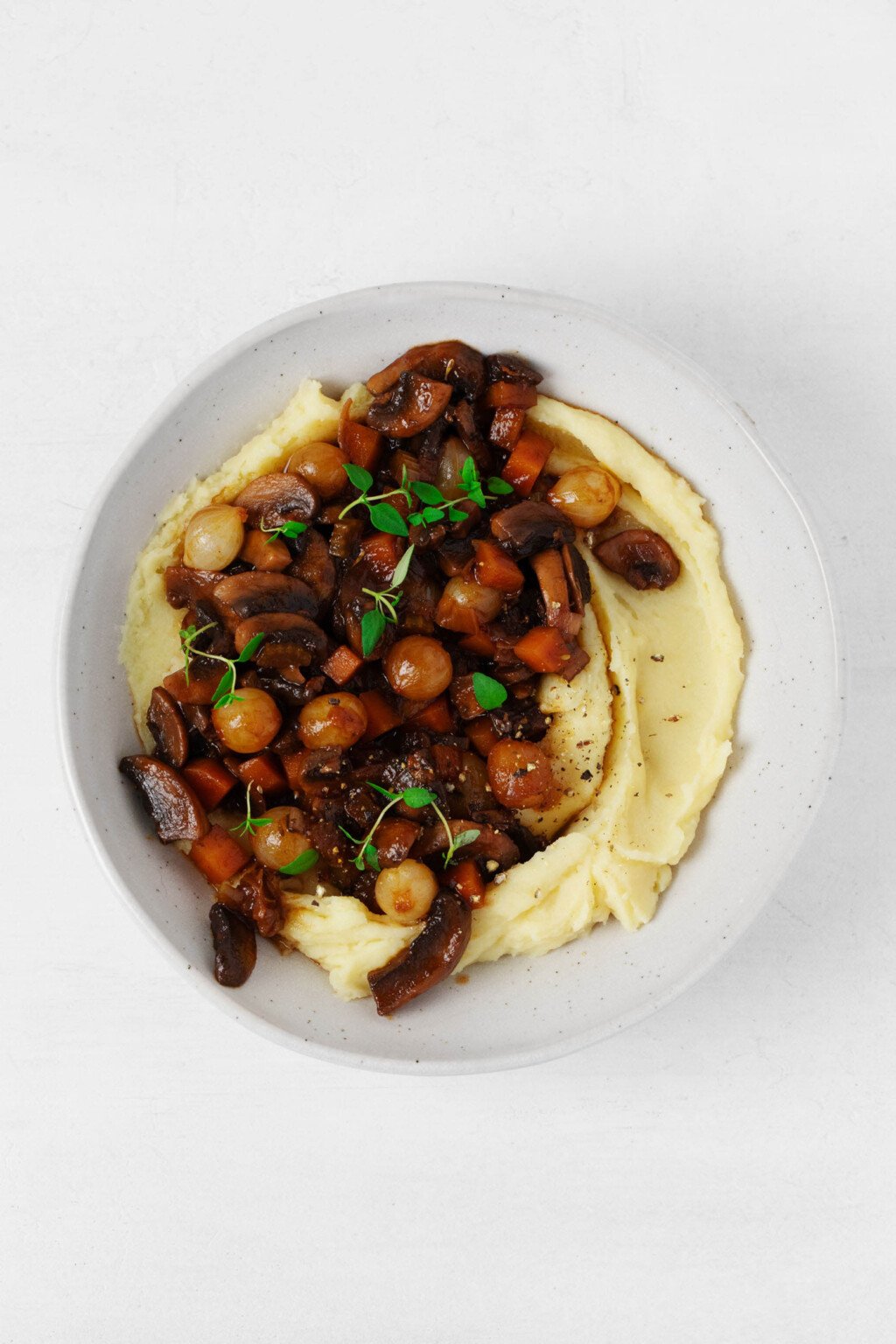
I love this recipe so much, and I’m already thinking about when I’ll make it again (maybe Christmas Eve?).
It’s joining my mashed potato bowls with tempeh gravy, skillet lasagna, and chickpeas à la king in the category of favorite comfort food classics, made vegan.
I hope you’ll feel the same!
xo

